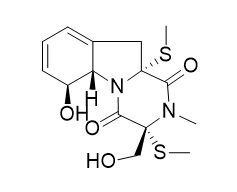Bisdethiobis(methylthio)gliotoxin
Bisdethiobis(methylthio)gliotoxin is a platelet activating factor (PAF) antagonist.
Inquire / Order:
manager@chemfaces.com
Technical Inquiries:
service@chemfaces.com
Tel:
+86-27-84237783
Fax:
+86-27-84254680
Address:
1 Building, No. 83, CheCheng Rd., Wuhan Economic and Technological Development Zone, Wuhan, Hubei 430056, PRC
Providing storage is as stated on the product vial and the vial is kept tightly sealed, the product can be stored for up to
24 months(2-8C).
Wherever possible, you should prepare and use solutions on the same day. However, if you need to make up stock solutions in advance, we recommend that you store the solution as aliquots in tightly sealed vials at -20C. Generally, these will be useable for up to two weeks. Before use, and prior to opening the vial we recommend that you allow your product to equilibrate to room temperature for at least 1 hour.
Need more advice on solubility, usage and handling? Please email to: service@chemfaces.com
The packaging of the product may have turned upside down during transportation, resulting in the natural compounds adhering to the neck or cap of the vial. take the vial out of its packaging and gently shake to let the compounds fall to the bottom of the vial. for liquid products, centrifuge at 200-500 RPM to gather the liquid at the bottom of the vial. try to avoid loss or contamination during handling.
Institute of Food Science & Technology2021, 18 December.
The Pharmaceutical Society of Japan2018, 138(4):571-579
Molecules 2021, 26(4),1092.
J Insect Sci.2020, 20(5):18.
PLoS One.2017, 12(3):e0173585
Biology (Basel).2020, 9(11):363.
J Korean Soc Food Sci Nutr2020, doi: 10.3746.
J Ethnopharmacol.2017, 198:205-213
JLiquid Chromatography & Related Tech.2021, 10826076.
Curr Issues Mol Biol.2024, 46(6):6018-6040.
Related and Featured Products
Chem Pharm Bull (Tokyo). 1986 Jan;34(1):340-4.
Studies of platelet activating factor (PAF) antagonists from microbial products. I. Bisdethiobis(methylthio)gliotoxin and its derivatives[Reference:
WebLink]
METHODS AND RESULTS:
A platelet activating factor (PAF) antagonist, designated as FR-49175, was isolated from fermentation products of Penicillium terlikowskii and identified as Bisdethiobis(methylthio)gliotoxin (1). The IC50 value of this compound for PAF-induced rabbit platelet aggregation was 8.4 μM.Some derivatives of Bisdethiobis(methylthio)gliotoxin (1) were synthesized and their inhibitory activities of PAF-induced platelet aggregation were examined.
CONCLUSIONS:
Among these compounds, 5a, 6-anhydrobisdethio-3, 10a-bis(methylthio)gliotoxin (8) showed the most potent PAF inhibitory activity (IC50; 4.4 μM).
Tetrahedron Letters, 2013, 54(8):744-748.
Penicolinates A–E from endophytic Penicillium sp. BCC16054[Reference:
WebLink]
METHODS AND RESULTS:
Five new picolinic acid derivatives, penicolinates A–E (1–5), together with four known compounds including phenopyrrozin (6), p-hydroxyphenopyrrozin (7), gliotoxin (8), and Bisdethiobis(methylthio)gliotoxin (9) were isolated from endophytic Penicillium sp. BCC16054. The chemical structures were established from spectroscopic data-1D and 2D NMR experiments, IR, UV, and HRESIMS.
CONCLUSIONS:
These compounds were evaluated for antimalarial and antitubercular activities and for their activity against Bacillus cereus and Candida albicans along with cytotoxicity against both cancerous and non-cancerous cells.
Nat Prod Res. 2014;28(2):86-94.
A new diketopiperazine alkaloid from Aspergillus oryzae.[Pubmed:
24116376 ]
METHODS AND RESULTS:
Investigation of bioactive secondary metabolites from terrestrial Aspergillus oryzae sp. MMAO1 using M2 medium afforded a new diketopiperazine alkaloid, 7,9-dihydroxy-3-(1H-indol-3-ylmethyl)-8-methoxy-2,3,11,11a-tetrahydro-6H-pyrazino[1,2-b]isoquinoline-1,4-dione (1a), containing the unusual amino acid L-6,8-dihydroxy-7-methoxyphenylalanine. This was co-isolated with ditryptophenaline (2), cyclo-(Tryp,Tyr) (4), cyclo-(Pro,Val), α-cyclopiazonic acid (3), kojic acid and uridine. Re-cultivation of the fungal strain on Dox medium led to the production of Bisdethiobis(methylthio)gliotoxin (5), pseurotin A (6) along with linoleic acid, α-cyclopiazonic acid (3) and kojic acid.
CONCLUSIONS:
The chemical structure of the new diketopiperazine alkaloid including the relative configuration was determined by 1D and 2D NMR spectroscopy and HR-ESI-MS spectrometry, and by comparison with the related literature. The new alkaloid (1a) showed no antimicrobial activity or cytotoxicity against brine shrimps.



